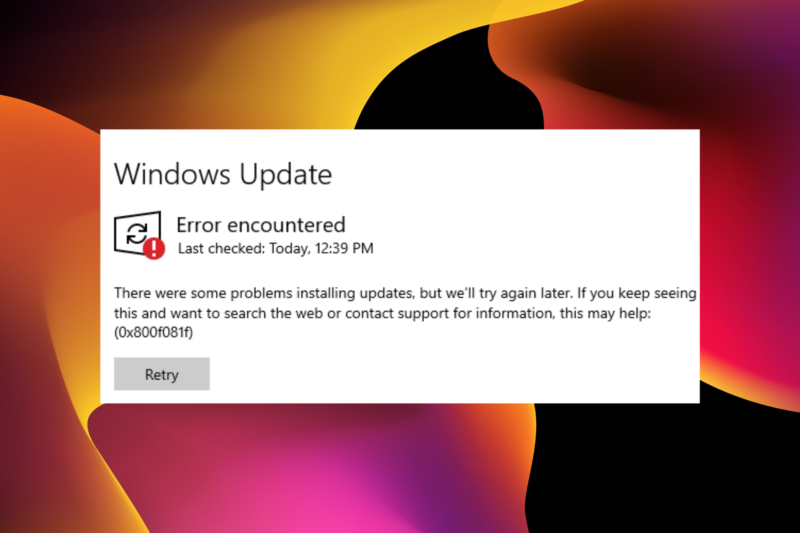The error 0x800F081F is a general Windows 10 error that occurs when you try to install or update an app. This article will show you how to fix the error and get back on track with your Windows 10 apps.
If you are experiencing the windows 10 20h2 update error 0x800f081f on Windows 10, there are a few fixes. The first is to try updating your device drivers. Another fix is to install the latest service pack for your operating system.
When attempting to upgrade Windows 10, the error 0x800f08 appears. If this issue occurs, it indicates that certain important update files are missing and must be replaced.
On Windows 10, updating Windows is one of the most essential activities you should do on a regular basis. However, you may face error number 0x800F081F when upgrading Windows operating systems, which may display an error message similar to this:
“We had some difficulties installing updates, but we’ll try again later. If you keep seeing this and wish to look for more information on the internet or contact assistance, try this: (0x800f081f)”
The techniques I’ve listed below will assist you in resolving this problem.
What is the 0x800F081F Windows Update error?
When trying to update your Windows version, the error code 0x800F081F may appear. More precisely, this issue occurs when attempting to install the cumulative update KB500139, KB4054517, or KB5000842.
When the.NET Framework 3.5 is not installed or deactivated on your PC, you are more likely to get the 0x800F081Ferror.
Methods for resolving the 0x800F081F Windows Update error
I’ve included a few ways that will assist you in resolving the 0x800F081F problem. Follow the procedures outlined in each approach to see whether they assist you in resolving the issue.
.NET Framework 3.5 is enabled.
If the.NET Framework 3.5 is deactivated or removed, you will most likely get the 0x800F081F error, and you will need to enable it. Here’s how to go about it.
To begin, open the Control Panel.
2. Select ‘Uninstall an application’ from the Programs menu.

3. Now, on the left hand side, click the Turn Windows Feature on or off button.

4. Now choose the.NET Framework 3.5 check box (includes .NET 2.0 and 3.0).

5. Finally, click OK.
6. Next, choose the Download files from Windows Update option.
7. Now you must wait for the.NET Framework 3.5 to be downloaded and installed.
8. Restart your computer.
Now you may attempt to upgrade Windows, hoping that the error number 0x800F081F does not appear. If you’re still getting the same problem, try implementing the next method.
SFC and DISM scans should be run.
If critical files are destroyed, Windows updates may be hampered, resulting in error 0x800F081F. In this instance, both the command prompt and the command line are useful tools for scanning and repairing damaged files on the Windows operating system. You may watch the video below or follow the instructions below to conduct the SFC scan:
1. Run the Command Prompt as an administrator.
3. Press Enter after typing sfc /scannow.
4. Now you must wait for the SFC scan to finish.
5. Reboot your computer.
If a mistake occurs during scanning, the Command Prompt will correct it. If you’re still getting the 0x800F081F problem, try doing a DISM scan to see if it helps. Here’s how you can go about doing that.
1. Run the Command Prompt as an administrator.
3. Now press Enter to run Dism.exe /Online /Cleanup-image /Restorehealth.
4. Now you must wait for the DISM scan to finish.
5. Restart your computer after that.
Hopefully, this will resolve the 0x800F081F issue; but, if the problem persists, go to the following step.
Run the Troubleshooter for Windows Updates.
If there is anything you can’t do right now, you should try using the Windows Update Troubleshooter to resolve problem number 0x800F081F. Here’s how to go about it.
1. Open the Control Panel by searching for it in the Windows search box.
2. After that, change the View by: option to Small icons.

3. Select Troubleshooting from the drop-down menu.

4. Select Fix issues with Windows Update from the drop-down menu.

5. After that, press the Next Button.

6. Now you must wait for the troubleshooting procedure to finish.
7. Restart your computer.
This article will show you how to repair Windows update 0x8007000d.
If the issue persists, go on to the next technique.
Install the Windows Update manually
If none of the following ways work for you, you’ll have to attempt manually installing Windows Update.
To manually install the updates, follow the procedures outlined below.
1. On your keyboard, press the Windows logo, enter Settings, and then click on it.
2. Select Update & Security from the drop-down menu.

3. Next, choose Check for Updates.

Note: If any updates are available, they will appear on your screen now.
4. Select “Download and Install” from the drop-down menu (if an update is available).
5. Allow the updates to download and install on your computer.
Windows Update Component should be restarted.
Many people have stated that reinstalling the Windows Update component fixed the problem for them. This is how you can do it as well.
- In the Windows search box, type Command Prompt.
- Select Run as Administrator from the context menu when you right-click the Command Prompt icon.
- After that, enter the commands listed below, pressing Enter after each one.
- Stop pieces on the internet
- wuauserv wuauserv wuauserv wuauserv
- appidsvc appidsvc appidsvc appidsv
- cryptsvc cryptsvc cryptsvc cryptsvc
- SoftwareDistribution% Ren% systemroot% Ren% systemroot% Ren% systemroot% Ren% systemroot% Ren SoftwareDistribution.bak
- catroot2.bak ren % systemroot % system32catroot2 % system32catroot2 % systemroot % system32catroot2
- Start bits on the internet
- wuauserv wuauserv wuauserv wuauserv
- appidsvc.net Start
- Start cryptsvc on the internet
- Exit the Command Prompt at this point.
If you’re still having problems with the 0x800F081F error, try the final option.
The SoftwareDistribution Folder may be rebuilt by doing so.
Our Windows system saves updates in a folder called SoftwareDistribution, and this folder is often corrupted, resulting in the 0x800F081F problem. We’ll have to rebuild the folder to cope with this issue. You may simply delete the folder from the command prompt. Here’s how to go about it.
1. Press the Windows key + R at the same time.
2. Now, in the Run program, enter services.msc and click Enter.

3. Among all the active services, look for the Windows Update service.
4. Now, right-click on Windows Update and choose Stop from the drop-down menu.

5. Finally, close the Services tab.
6. Go to the C:Windows folder next.
7. Go to the SoftwareDistribution folder and look for it.

9. Finally, either delete or rename the folder.
10. Now, open the Services window that has been minimized.
11. Next, right-click on Windows Update and choose Properties.
12. Finally, choose the Start option.

13. After that, follow the steps in method 4 to manually install the Windows update.
If you followed the instructions above, the error should have been resolved successfully.
So that’s all there is to know about Windows Update Error 0x800F081F and how to solve it. I hope you find it helpful; if you have any more questions or concerns, please leave them in the comments section below, and I will do my best to respond.
a similar solution:
The net framework 3.5 windows 10 error 0x800f081f is a problem that has been present for a while. Microsoft released a fix to fix the issue in Windows 10.
Frequently Asked Questions
What does error code 0x800F081F mean?
This error code is a Windows 10 error that usually occurs when the computer has been shut down improperly.
How do I fix a Microsoft Net Framework error?
The Microsoft Net Framework error is a common issue with Windows systems. If you are experiencing this error, you may need to reinstall the Microsoft Net Framework.
How do I fix error code on Windows 10?
This error code is caused by a program that has stopped working. You will need to uninstall the program and then reinstall it.



